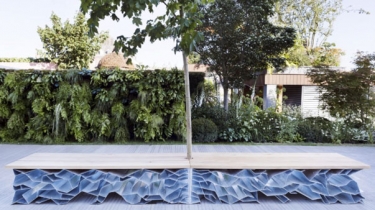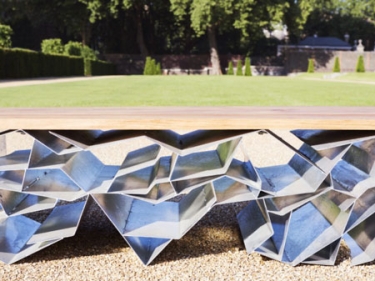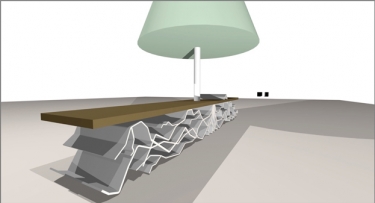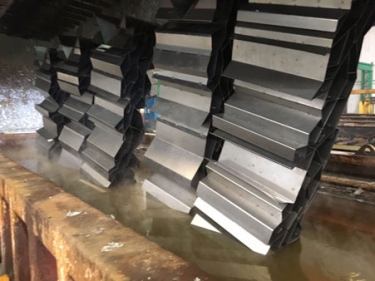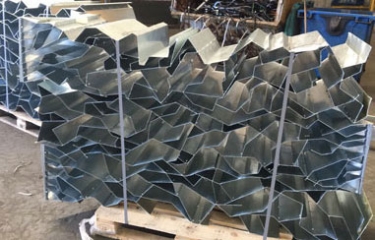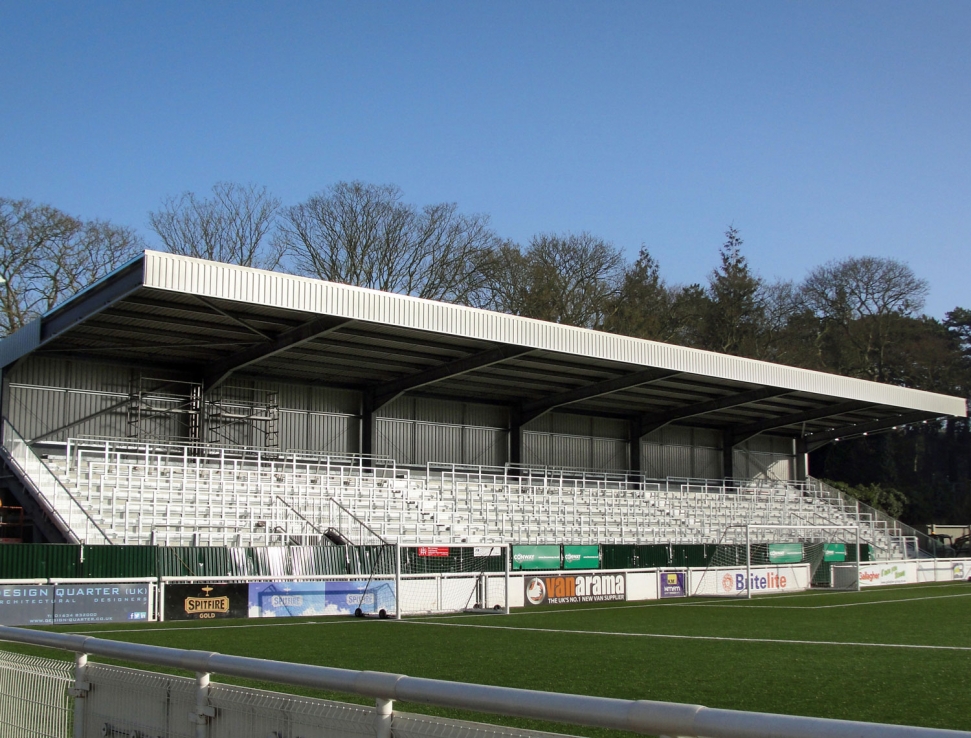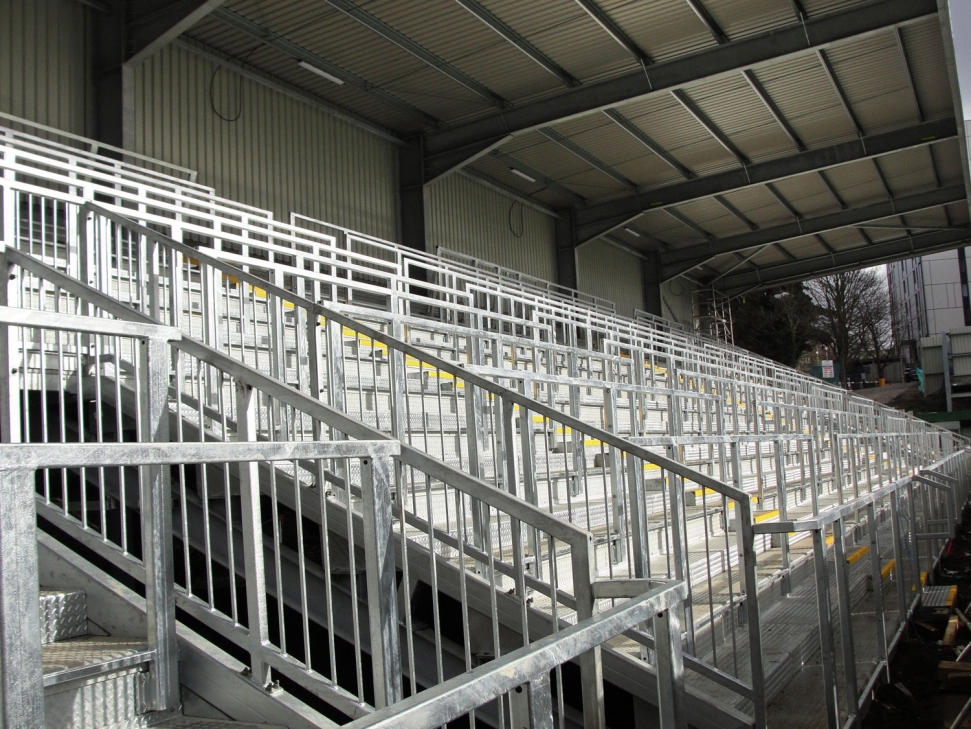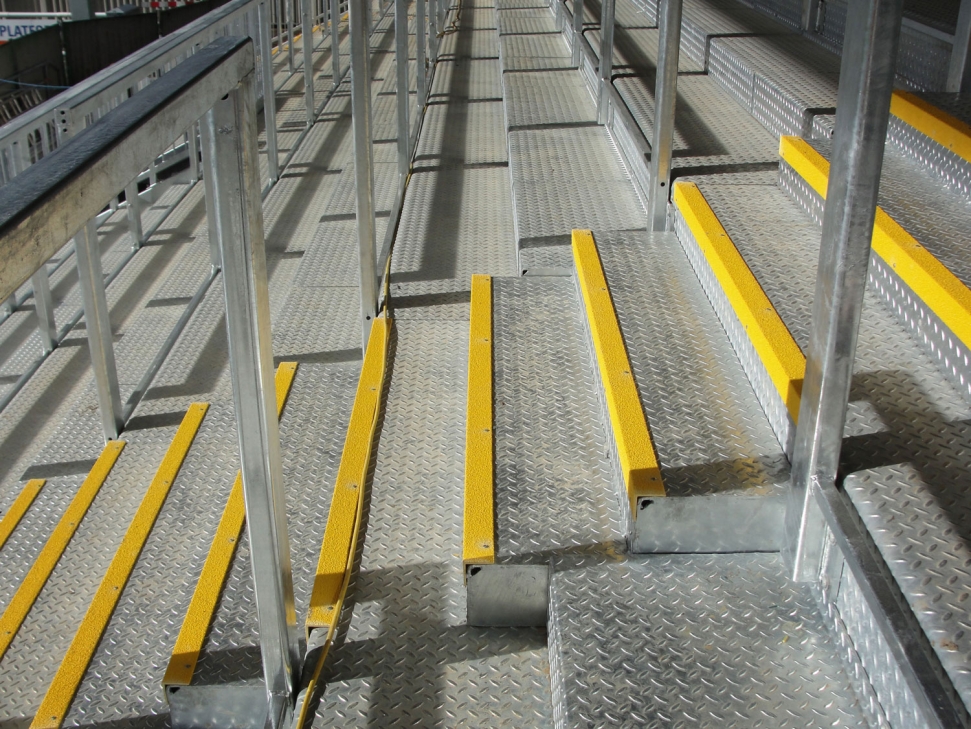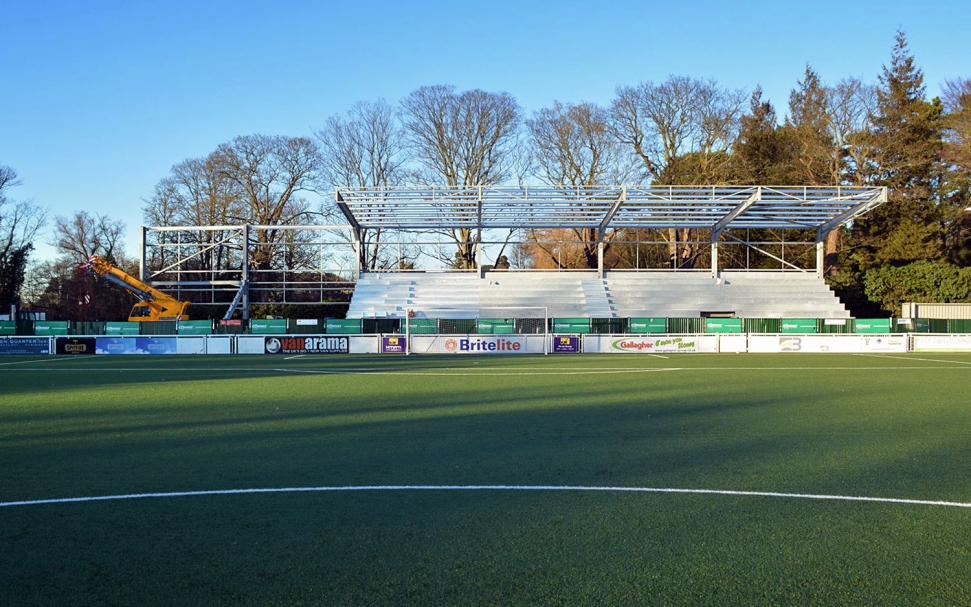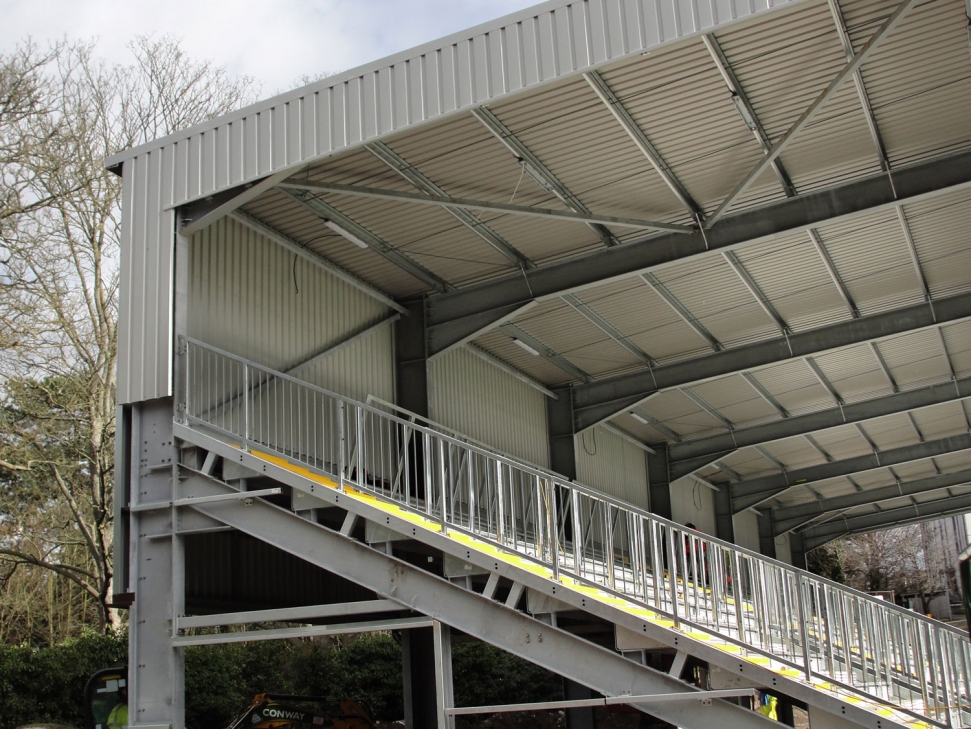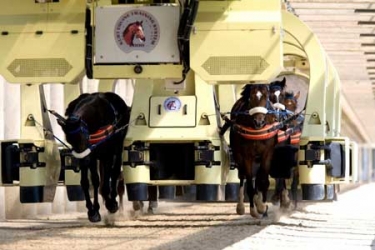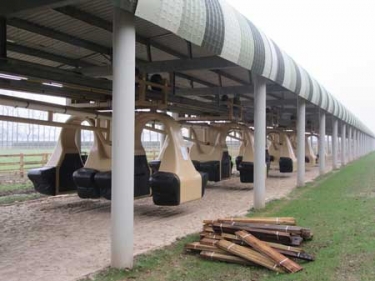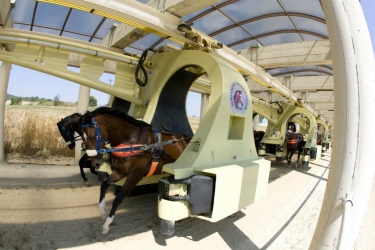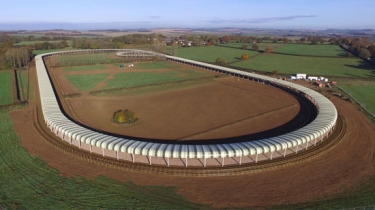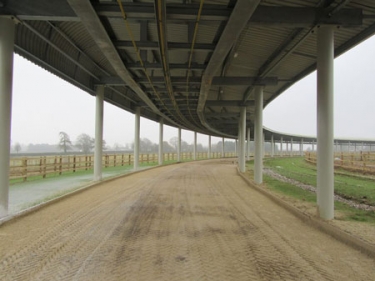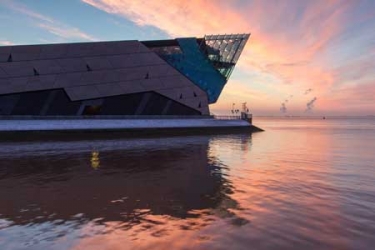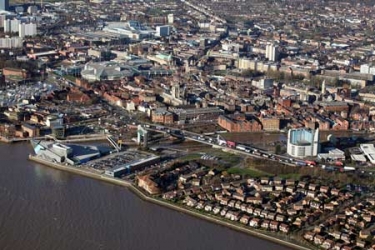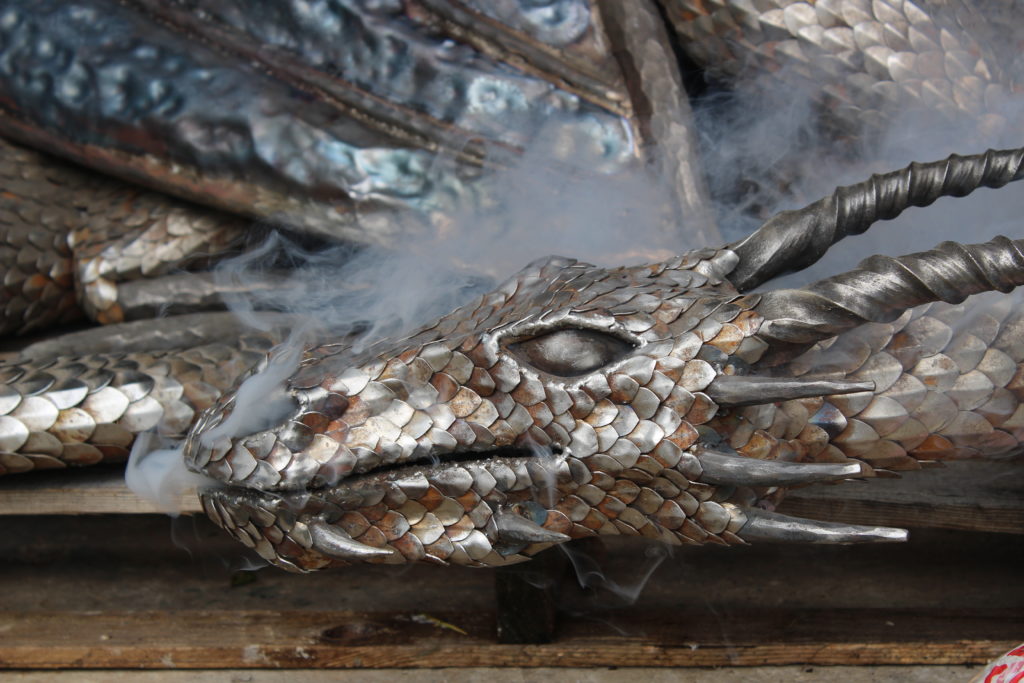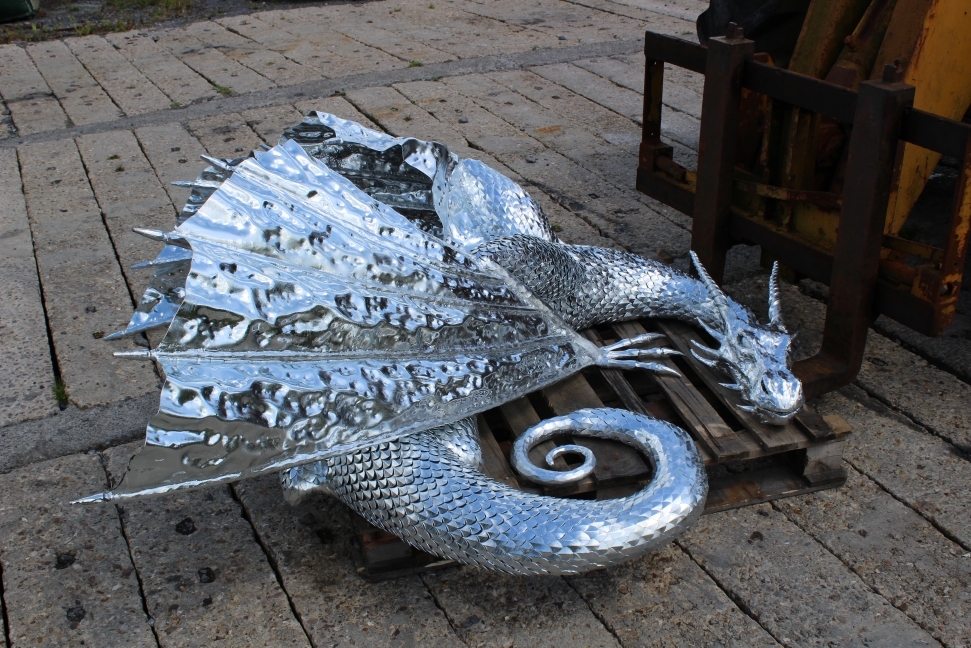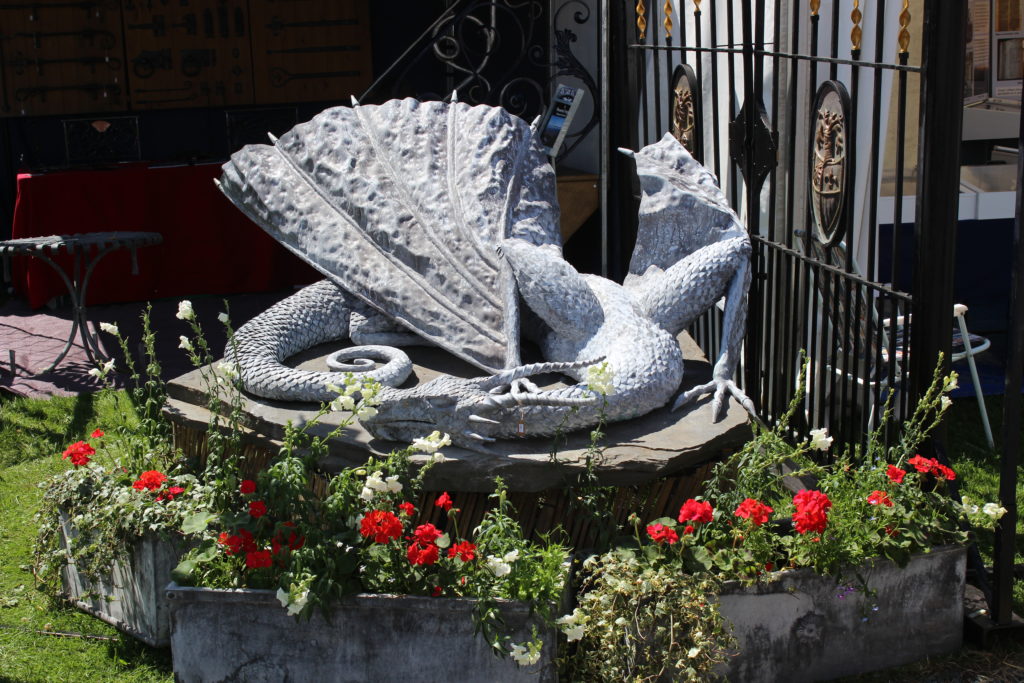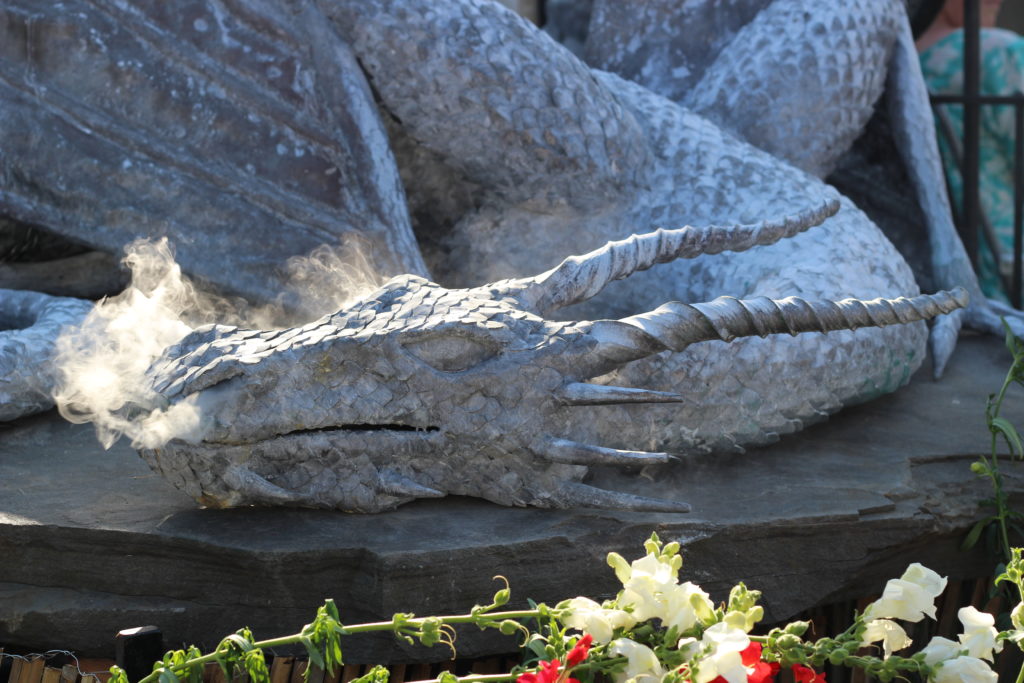Majestic steel sculpture unveiled
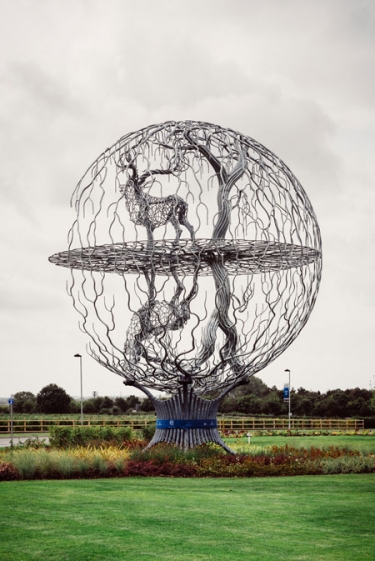

Majestic steel sculpture unveiled in Essex: New artwork by Matthew Lane Sanderson, hot dip galvanized by Joseph Ash Telford.
A stunning new piece of artwork has recently been unveiled in Chelmsford, Essex. Matthew Lane Sanderson is the artist, and he invited Joseph Ash Galvanizing along to the launch party.
A new housing development has been built in Essex, in an area just north of Chelmsford. The development is called ‘Beaulieu’ and it will eventually include over 3600 new homes, playgrounds, a railway station, commercial areas, and parkland.
The development has been built by Countryside and L&Q, who also wanted to include sculptural and functional works of art in the landscape to tell the story of the land’s previous Tudor owner, King Henry VIII, who had a palace and a deer park there.
The development partners chose a series of talented artists, and Matthew Lane Sanderson – a ‘Big-Art’ sculptor from Herefordshire – was commissioned to create one of the pieces of art.
The launch party for the sculpture – called ‘The Crowned Stag’ – took place on Thursday 7 September 2017.
Sanderson’s sculpture at Beaulieu
For the commission at Beaulieu, Sanderson created a spherical sculpture, with an intricate design, that depicts a regal reflection of a stag under a tree, set on a reflected crown base. The statue is made from six tonnes of steel and zinc and is ten metres high. The artist has also inscribed a poem into the base which reads as follows:
“All things held in one small globe,
Spinning eternal in endless strobe.
Plants, water, animals, light.
Future, past, day, night.
All is balanced on everyone’s crown,
In every country, in every town.”
The sculpture has a special place in the Beaulieu development as it stands proud at the entrance to the new housing estate/town.
Sanderson said of the sculpture: “This work of art shall forever mark the status of this place both past, present and future. It is a symbol that not only conveys the beauty of natural form, but the hope we all share for balance in all things.”
Joseph Ash Galvanizing and Matthew Lane Sanderson
Sanderson is well-known to Joseph Ash Galvanizing, as he works in steel and regularly asks us to protect the finished sculptures with a galvanized finish.
A galvanized coating on steel protects the metal from rust and enables it to be protected from the elements for many years to come.
Sanderson has previously asked Joseph Ash Galvanizing to hot dip galvanize works of art including ‘Conduct’ at Solihull School.
He has been pleased with the professional service and level of quality that Joseph Ash provides, and therefore asked one of our plants to galvanize the sculpture for Beaulieu.
As galvanizers for the project, Mick Jackson and Ewelina Bharj from Joseph Ash Galvanizing were invited to the launch party in Chelmsford.
Mick Jackson said: “It is always an honour for Joseph Ash Galvanizing to be asked to treat huge works of steel art, by amazing artists such as Matthew Lane Sanderson. Hours and hours of work go into the design and creation of these sculptures and it is imperative that our galvanizing plants do justice for the artists, by providing the best quality galvanized finish that we can.”
Ewelina Bharj said: “The launch party for Matthew’s new sculpture was amazing and awe-inspiring. After seeing the sculpture being galvanized at our Telford plant, it was great to see the finished project standing tall and proud in its final location in Chelmsford. It is a beautiful piece of art, and Matthew looked just as proud as the statue at the party. I hope the residents of Beaulieu will love the sculpture over the coming years as much as I do.”
You can read more about Matthew Lane Sanderson here.
You can read more about Beaulieu here.
See more photos of ‘The Crowned Stag’ sculpture here.
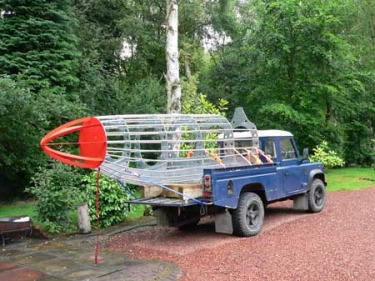
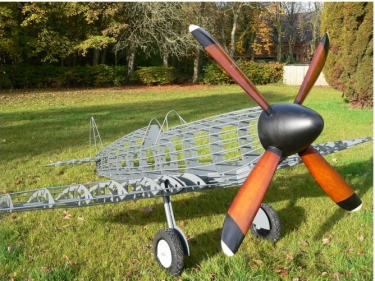
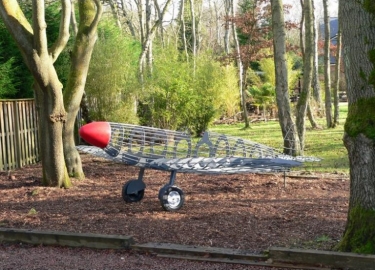
Model Spitfires fabricated from steel to celebrate an icon of the skies during WW2, and a grandfather’s legacy.
In just a few weeks’ time, on 3 September, Great Britain will be remembering the day 78 years ago when Neville Chamberlain declared war on Germany and the start of WW2. It was a sad day for the nation, but especially for those who had already lived through the horrors of WW1, which had finished only two decades earlier. Much had changed in terms of military might in 21 years however, including the development of the Spitfire, a “masterpiece of aerodynamic engineering”* and an icon of the skies, especially during the Battle of Britain (July – October 1940).
To celebrate the hard work and success of the Spitfire, and to commemorate RAF airmen and a grandfather’s legacy, an engineering company in Northumberland – Lutman Aero Works – began to fabricate custom built Lutman Spitfire MK XII’s in 2016 as sculptural steel commissions.
Joseph Ash Galvanizing has been proud to provide the galvanized finish for one of these commissions.
Lutman Aero Works – a history
In 1924, the first model shop in the world was opened by Charles W. Lutman in Newcastle-Upon-Tyne. At that time, the North East of England was a hot bed of inventive engineers, and there are even rumours that the Lutman family had attempted flight on Newcastle Town Moor before the Wright Brothers.
In the 1920s, designs for aeroplanes were drawn, and scale models made from balsa wood, which were then tested in wind tunnels, before the full-size aircraft were manufactured and tested. The staff at The Model Shop not only supplied the balsa wood to the Air Ministry for aeroplane models, but they also assisted with the wind tunnel models for the Supermarine Spitfire.
Spitfire commissions
The Lutman family today are proud of their family’s heritage with regards to the Spitfire. Consequently, Lutman Aero Works was born, which today fabricates half-size pole mounted and ground mounted model Lutman Spitfire MK XII’s as memorials, garden sculptures, office features or gate guardians.
The wing ribs and fuselage formers of the models are plasma cut from steel sheet, and the stringers are made using a thick wall steel tube. After fabrication, the front of each airframe is galvanized by Joseph Ash Galvanizing and then powder coated (by another supplier) to marine offshore standards, to prolong the life of the steel and protect it from the elements.
The wings are then attached to the fuselage wing box with marine grade stainless steel fastenings, which helps with transportation and installation.
Andrew Booton from Joseph Ash Galvanizing Telford said: “It is important to commemorate the hard work and sacrifices of people during the World Wars, and to also remember the engineers and the machines that helped to turn the tide of the Wars in Britain’s favour. This is especially the case of the Spitfires which battled against the Luftwaffe over our skies during WW2. The work of Lutman Aero Works and their artistic commissions helps us to remember and preserve our history. It is an honour to treat their steel with metal finishing coatings, in order to preserve their works.”
(* https://www.military-history.org/articles/world-war-2/history-of-the-spitfire.htm)
Bowled over with new steel railings at bowling green: refurbishment of fencing panels around 18th century bowling green in Cannock.
Cannock Bowling Green, which dates to 1760 and sits in the centre of Cannock Town Centre in Staffordshire, has recently undergone a project to refurbish its steel fencing, surrounding the Green. Joseph Ash Walsall was pleased to play a part in the project.
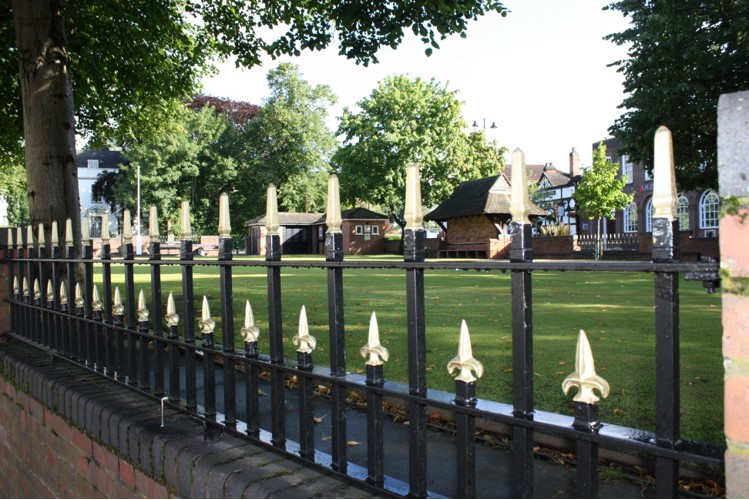
About Cannock Bowling Green
Cannock Bowling Green sits in the centre of Cannock Town Centre in Staffordshire and dates to 1760. Its members include people from the local community, some of whom have been enjoying everything the Club offers since the 1970s.
Members take pride in the green and decided it was time to repaint the railings surrounding the Club. The Bowling Club Committee originally obtained quotes to have the railings sanded down and repainted, however the Walsall plant of Joseph Ash Galvanizing suggested an alternative solution involving shot blasting, galvanizing and powder coating, to protect the steel and avoid further expensive maintenance expenditure for many years. Stan Williams, a life Honorary Member of the Club, and former MD and Chairman of two galvanizing plants in Walsall and Netherton, was an advocate for a full treatment as he knows the benefits that galvanizing and powder coating can bring.
- Shot blasting: Before metal is galvanized it needs to be cleaned to give it a smooth surface. One of the most effective ways to create this surface is to shot blast it. Shot blasting fires a high-pressure spray of abrasive steel materials onto a rough surface to create a smooth surface.
- Hot dip galvanizing: Hot dip galvanizing has been used worldwide for well over a century because it provides a long-life, low-maintenance corrosion protection which safeguards steel from atmospheric attack. Applying a hot dip galvanizing process to steelwork provides fabrications with a robust, durable and corrosion protective finish that under normal conditions will last for many years without maintenance of any sort.
- Powder coating: Powder coating is a type of paint that is mainly applied to metals to provide a harder finish than a normal paint. The paint is applied as a powder electrostatically from a spray gun and is cured in an oven under a high heat to form a tough, durable skin. Powder coating paints come in many colours and can be used to create different finishes such as textured or metallic.
Going the extra mile
As well as providing shot blasting, galvanizing and powder coating, Joseph Ash also offered to provide the transportation for the steel – weighing in at about 1 tonne – as part of their competitive quotation.
For Joseph Ash Walsall to treat the steel, the heavy panels had to be cut free from the wall surrounding the Green, taken away for processing, and refitted to the wall.
President of the Bowling Club, Tony Rose, purchased the necessary tools to free the panels and new galvanized bolts to replace the rusty old bolts which snapped because, for decades, they had been painted over several times. Permission was also obtained from Staffs County Council for Joseph Ash Walsall to park their lorry alongside the Green in the pedestrianised area to load and unload the material. Arrangements were also made for enough strong members of the Club to be available to help the Joseph Ash Walsall driver lift the panels from the Green onto the vehicle for processing at the Joseph Ash Walsall plant.
The local Conduit Trust offered a grant of £1,000 towards the overall cost of the project, and with a contribution of expertise from some members, the club funds and the cooperation of the Joseph Ash Walsall, the project has now been successfully completed.
The tips of the black panels have even been painted gold to match similar fencing around the town which is maintained by Cannock Council.
The cost of running and maintaining the Bowling Green Club is covered by an annual subscription from members and contributions from events, but most of the work, cutting and fertilising the grass, and tending to the flowers and surrounding area is done by a few dedicated members. A trust deed dated 1896 establishes that the land is to be retained as a bowling green, in perpetuity, providing there are at least 15 members available to maintain the green in an attractive and practical condition. The green is an attractive area in the town, creating a pleasant ambience where the public can see over the wall or can enjoy a peaceful rest on the ancient snake benches when members are playing bowls.
The team at Joseph Ash Walsall enjoyed working on this project and are delighted to see how stunning the newly refurbished railings look in the centre of Cannock.
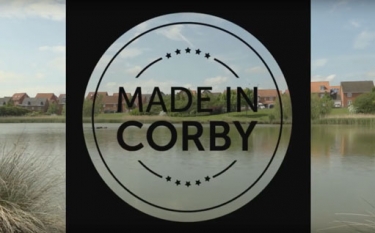
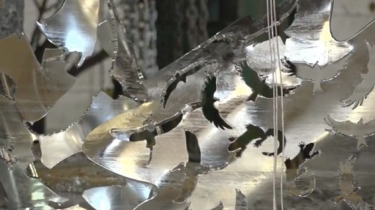
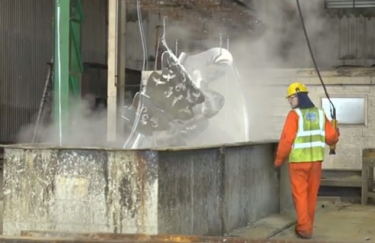
The residents of Oakley Vale, in Corby have just unveiled new works of art by sculptor Richard Janes, as part of a ‘Made in Corby’ scheme to bring art to the masses. Premier Galvanizing Corby was proud to play a part by galvanizing the steel.
‘Made in Corby’ is an exciting organisation that recognises and draws inspiration from the identity and reputation of Corby. As part of a national Creative People and Places network, funded by the Arts Council of England, its aim is to inspire local people from Corby to take the lead in experiencing, creating and taking part in high quality arts and cultural activities. With this in mind, ‘Made in Corby’ created an ambitious and exciting three-year programme, involving local residents, to install sculptural works of art at Oakley Vale, a 436-acre housing development situated in the South West of Corby.
‘Made in Corby’ encouraged local people from Oakley Vale to get involved, right from the start, in commissioning the works of art. An enthusiastic panel of residents from Oakley Vale Community Association volunteered and went through a process of deciding what would be right for the community. They took part in workshops, they ran design workshops for local children to take part in the process, and they even went on a road trip to London to see various pieces of sculptural art as part of an inspirational exercise.
The next step was to choose the artist. Under the ‘Made in Corby’ banner, it had to be someone local and gifted, and sculptor Richard Janes, was chosen.
Richard’s work includes commissions from public, corporate and private clients. He was happy to take part in the ‘Made in Corby’ project and he set to work designing three pieces of sculpture, taking inspiration from the local surroundings, the oak forest that was originally on the site of the new housing development, as well as the existing wildlife and the industry that is still alive in the town:
Richard Janes explains his rationale for the designs in this video produced by ‘Made in Corby’ and HD Media CIC.
The children at the local community centre also had a hand in the design which reflects the local wildlife of the area.
Richard Janes and Premier Galvanizing Corby
The sculptures designed and fabricated by Richard Janes are primarily made from steel. As steel corrodes and rusts over time, it needs to be protected with a galvanized coating. Premier Galvanizing Corby – a division of Joseph Ash Galvanizing – was chosen to provide this service.
The steel was delivered to the Corby plant and representatives from ‘Made in Corby’, alongside Richard Janes, were invited to the galvanizing plant to see the metal treatment in action, and so that they could film the processes as part of their video diaries.
Richard Janes describes the hot dip galvanizing process in the video:
“The galvanising is [necessary] to make the sculpture last much longer. The galvanising is 130 microns thick, which will provide more than 60-70 years before the sculptures need treating again. The galvanizing is also important as it reflects Corby’s industry, an industry that is still alive in the town.
Step one is the pickling process which removes the mill scale and any deposits that are on the steel, so that the zinc can adhere to the sculpture. After pickling, step two happens, where the steel is put into a flux bath which allows the zinc to run all over the steel very quickly, creating an even coating. Then – step three – the steel is dipped into the zinc bath at 450 degrees, and it emerges looking all silver and magical. Finally, it is dipped into a cleaning bath which puts a film on the surface which gives the surface greater longevity.
Seeing it rise out of the zinc tank is magical. It brings the creative idea into a reality.”
You can watch the full video here.
The culmination of the project

The ‘Made in Corby’ project was a great success and everyone was happy to play their part, from the local community, to the sculptor, to Premier Galvanizing, the Arts Council of England, and of course the people behind ‘Made in Corby’.
The three sculptures have been erected at Oakley Vale and the grand unveiling took place on Saturday 15 July.
Helen Wilmott from ‘Made in Corby’ said it is a great way to give “local people a say about how public money is spent on art”.
Justin Deegan from Premier Galvanizing Corby said: “We were honoured to be chosen as the hot dip galvanizers for this wonderful project. We attended the unveiling on Saturday and the finished products look beautiful and amazing against the backdrop of Oakley Vale. Well done to everyone involved!”
__________________________
(The photos to the right show elements of the sculptures being galvanized at Premier Galvanizing. Richard Janes appears in the photos in the blue shirt. Justin Deegan from Premier Galvanizing is in the brown jumper.)
Galvanized steel used in benches at the Chelsea Flower Show 2017.
In 2016 JAILMAKE was commissioned by the RHS to design new benches for the 2017 Chelsea Flower Show. As part of the project, JAILMAKE used the services of Premier Galvanizing (a division of Joseph Ash Galvanizing) to galvanize the steel.
JAILMAKE is a London-based design 3D practice. The company describes itself as a collaborative practice of 3D designers and engineers who design and make, across all scales and typologies. With a wide-ranging portfolio of interesting and unusual projects under their belt, the RHS (the Royal Horticultural Society) decided the company would be a good fit to build a series of benches, for event-goers at the 2017 Chelsea Flower Show. The team at JAILMAKE were happy to take on the project.
The RHS ordered six benches in total, and after a series of sketches, meetings and discussions, the final design looked like the drawing to the right.
Each bench would be 4m long, made from folded steel, with a wooden structure (made from European Oak) on top, where people would sit. They would be delivered in two parts to the event, and constructed on site, with the wooden structure laid across the top.
Being commissioned by the RHS, for the Chelsea Flower Show is an honour and JAILMAKE wanted to do a great job. In a project like this, a large part of ‘doing a great job’ not only revolves around the aesthetics and unique design, but also around the quality of materials, the finish, and the health and safety – i.e. ensuring the seats would be safe for members of the public to sit on.
To ensure the steel would be perfect, JAILMAKE contacted Premier Galvanizing to talk to them about treating the steel with a hot dip galvanized finish. Because the galvanizing process involves submerging the benches into boiling hot baths for hours, cleaning off any impurities from the steel and then submerging again, JAILMAKE had a concern about any potential distortion, as some of the steel plate in the structure was only 2mm thick. Premier Galvanizing were confident they could do a good job, and fully meet JAILMAKE’s specification and expectations.
As part of their service, Premier Galvanizing offered to visit JAILMAKE’s London studio to inspect the steel before the final fabrication work was completed. This proved invaluable because the Premier Galvanizing team members realised the steel would require some additional venting and drainage points.
When it comes to galvanizing, the correct venting and drainage can be the difference between a poor galvanizing finish, and a finish with premium quality.
Premier Galvanizing could look at the steel, and then suggest slight changes to the technical (not the aesthetic) design so that JAILMAKE would receive the best possible outcome after the steel had been dipped into the zinc galvanizing bath.
Once the slight modifications had been made, Premier Galvanizing dipped the steel at their plant in Corby. JAILMAKE took some pictures of the benches being hot dipped galvanized, which can be viewed to the right.
The steel for the benches was delivered to Premier Galvanizing on 9 May – just a few weeks before the flower show began. Premier Galvanizing carried out their service and returned the steel to JAILMAKE.
Two days before the Chelsea Flower Show 2017 began, JAILMAKE put the benches in place, laid the oak, and applied any finishing touches. A few days later the doors were open to the public, and the benches were there to be used, admired and enjoyed.
JAILMAKE were pleased to be commissioned for such a high-profile project. Premier Galvanizing was also immensely proud to work for such an interesting and innovative company, but to also be involved in such a prestigious event.
(Some of the photographs to the right by Ollie Hammick)
REIDsteel and Joseph Ash Galvanizing have scored a winning goal in a project to construct a new 1,768 capacity stand at the Gallagher Stadium.
Maidstone United football ground – known as the Gallagher Stadium – originally opened its doors in July 2012. At that time, it had a capacity of 3,000 people and it was a welcome addition to the area, as Maidstone United FC could play their first match in their home town in 24 years.
Since 2012 the Club’s fortunes improved as they were promoted through the Leagues, to the National League. League promotions came with expensive requirements however, some which dictated that the Stadium increase its capacity for supporters and fans.
A recent capacity addition came in the form of a new North Stand, constructed by REIDsteel. The new stand can house an extra 1,768 ticket holders, which brings the stadium’s total capacity up to 4,200, making it eligible for the Conference Premier.
REIDsteel worked directly with Maidstone United FC to design, draw, fabricate and erect the £850,000 structure at the club’s Gallagher Stadium – including steelwork, cladding, 500m of handrails and disabled access ramps. The architect on the project was Arete Architects and the contractor was FM Conway.
The steel-framed standing terrace has been built behind one of the goals. It consists of 11 double standing rows, formed with non-slip metal decking supported by a series of steel rakers. The stand has a 11m-wide cantilevering steel roof structure, which includes a 1m-high facia for advertising.
The structure includes 81 tonnes of steel, all fully galvanized by Joseph Ash Galvanizing.
REIDsteel designs, manufactures and erects all types of steel-framed buildings and structures nationally and internationally, including commercial premises, aircraft hangers, stadiums, bridges, process plants and industrial units and has experienced rising demand from sports clubs worldwide for stands of varying size and capacity.
Over the years, they have called on the expert services of Joseph Ash Galvanizing, to protect their steel fabrications with a variety of metal finishing treatments, predominantly galvanizing.
Because REIDsteel fabricates many huge structures, the Joseph Ash Chesterfield plant quite often treats their steel. The plant is perfect for REIDsteel projects as it is centrally located in Derbyshire near the M1, and is also the largest Joseph Ash Galvanizing site with acres of space, enabling it to handle the biggest of projects including storage before and after galvanising.
Tim Cook from REIDsteel said: “Working on the Maidstone United football ground has been an exciting project, and it’s great to see the stand in use by the club’s many fans. We were also happy to work with Joseph Ash Galvanizing on the project. We have been using their metal treatment services for many years and have always been happy with the high quality and professional service they provide.”
Steven Hopkins from Joseph Ash Galvanizing said: ”As always, it has been our pleasure to treat REIDsteel’s fabrications. We have worked with the company for several years on projects ranging from bridges and warehousing in Africa to general structures and stadiums and sports venues in the UK.”
Revolutionising UK racehorse pre-training.
In a picturesque and quiet village of Lambourn, West Berkshire, a revolutionary development has been taking place at the Kingwood Stud, a premier horse training facility owned by racehorse owner and breeder Mehmet Kurt.
Kingwood Stud is set to open the new Kurtsystems – a £20m pre-training system designed to provide controlled and synchronised exercise for young racehorses, to develop stronger bones, cartilages, muscles and tendons before they enter a traditional training regime.
SCWS – a Joseph Ash Galvanizing client – has been one of the contractors on the project, and Joseph Ash Chesterfield hot dip galvanized their steel.
_______________________
Kurtsystems is tipped to revolutionise racehorse training and is the first of its kind in the UK. The idea was developed by Mehmet Kurt after 20 plus years of researching horses, and testing a protoype near Istanbul in Turkey.
How it works
Horses are trained on an artificial surface training circuit, without jockeys, by being harnessed into specially designed ‘cabins’ which travel along an overhead rail track at set speeds. The speeds are managed by a computer controlled unit at the back of the cabins. The horses carry specialist saddles to replicate the weight of a jockey.
It is a mile-long circuit which can train up to 12 horses at a time. It can also be used to rehabilitate injured horses.
SCWS and Joseph Ash Galvanizing’s involvement
The architect for Kurtsystems is Sutton Griffin (based in Newbury), and the main contractor is Raymond Brown Construction Limited (based in Hamsphire). The monorail cars were designed by automotive engineers, Revolve Technologies (based in Essex). And SCWS (based in Norfolk) fabricated 411 tonnes of structural steel. SCWS then contracted Joseph Ash Chesterfield to treat the steel to promote its longevity.
The steel
The structural steel consisted of:
- 400 circular columns, all 5 meters long and collectively weighing 281 tonnes.
- 200 rectangular rafters, all 8.5 metres in length and collectively weighing 164 tonnes. This included large welded channel details to form the base of the curved roof, which meant the height of the rafters was over 2.4m.
- 400 x steel rail, 114mm in diameter and 6.8 metres long and collectively weighing 29 tonnes.
The 400 circular columns, the rectangular rafters and steel rail were all galvanized by Joseph Ash Chesterfield.
It was a big project for SCWS and Joseph Ash Chesterfield, and one that was completed successfully and on-time.
The future of Kurtsystems
The technology will start operating in 2017.
We send Kingwood Stud best wishes for the new project.
Every four years in the UK, a city is chosen to hold the title ‘UK City of Culture’. The first winner of this title was Derry/Londonderry in 2013, and the second winner is Hull.
Hull won the competition and will hold the title throughout 2017. This is great news for the people of Hull, as well as all the local companies and organisations that form part of the City. Premier Galvanizing (a division of Joseph Ash Galvanizing) is one such company and we are proud supporters of this great place!
The UK City of Culture award is given to a City that demonstrates “the belief in the transformational power of culture”. To act upon this achievement the people of Hull will spend the next 12 months hosting a variety of events and occasions such as concerts, art exhibitions, plays, dance shows and film screenings. Thousands of people are going to take part, from school children, to volunteers, to local businesses and organisations. (Find out what’s on by visiting the Hull 2017 website.)
Premier Galvanizing Hull has also played a part by becoming a member of the Hull 2017 Business Club, formed in order to help raise the £18million needed for an entire year’s worth of cultural events.
Alex Camp, general manager at Premier Galvanizing, said: “Premier Galvanizing is proud to be located in Hull and has always had a strong commitment to the area, employing local people and using local suppliers.
“The city is changing and we want to be part of its legacy for our employees, their families and the next generation, to feel as proud of Hull as we do.” (Hull Daily Mail)
As the year progresses we’ll report on all the great activities that will happen across this brilliant City, as well as our involvement in it.
Welcome to 2017! And welcome to Hull!
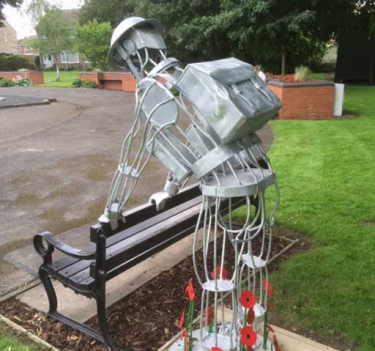
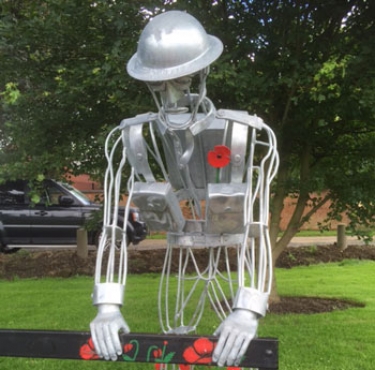
Tin Tommy sculpture, looking reflective at 2016 Remembrance Day Parade
On Sunday 13 November, the town of Immingham in North East Lincolnshire, held a Remembrance Day Parade at the Pelham Road War Memorial. The event was a fitting tribute to all soldiers who have lost their lives defending our country.
As part of the ceremony, a new statue stood at the War Memorial, leaning on a memorial seat covered in poppies. The statue was nicknamed Tin Tommy by local school children in the community, and he has become so popular that he even has his own Facebook page.
Tin Tommy was commissioned by the Barton Living Memorial Trust, who raised funds from the local council and communities. The aim of the Trust is “to educate the next generation about the World Wars and the sacrifices that so many made, and to keep the memory alive“.
When standing straight, Tin Tommy is a full-sized six foot high statue of a WW1 era British soldier, with red poppies painted onto parts of his frame. The bench that he leans upon has been designed to allow people to sit and “reflect on life, history and memory“.
Tin Tommy was fabricated by Hodson & Kauss, and hot dip galvanized by one of Joseph Ash Galvanizing’s divisions: Premier Galvanizing Hull.
Hodson & Kauss are expert fabricators who mainly fabricate bridges, walkways, fencing, staircases, and balustrades. Sometimes they are asked to fabricate unusal items such as Tin Tommy too. Hodson & Kauss have been using Premier Galvanizing Hull for all their galvanizing needs, for a long time. Premier Galvanizing are proud to have played a part in the construction of such an important statue.
(More photos of Tin Tommy can be found on the Joseph Ash Galvanizing Flickr site.)
The bread and butter of Joseph Ash Galvanizing’s work is centred around galvanizing steel used in transport, farming, construction and infrastructure. We do this for fabricators, fencing and agricultural manufacturers, and large structural steelwork companies. Every so often however we also receive a project from a steel sculptor. The works are unusual, intricate and detailed and we deem it an absolute pleasure to become a part of the sculptor’s artistic process.
The most recent pieces of art that came onto our yard at Joseph Ash Bridgend were two huge steel dragons, fabricated from Phoenix Forge Ltd, a bespoke metalwork and blacksmith’s business based in Carmarthen, South Wales.
Phoenix Forge generally specialises in traditional and contemporary metalwork, producing a wide range of hand forged artistic, decorative and functional ironwork including: gates, railings, balconies, public artwork, curtain poles, fireplace tools, restoration and bespoke commissions. They have also sculpted a number of dragons too!
Two such dragon installations were recently sent to Joseph Ash Bridgend: a dragon curled around a lamp post; and a sleeping dragon.
Will Holland from Phoenix Forge said:
“The dragon lamp post sculpture was vast with a wing span of approximately 6-7 feet and a nose to tail of about 9 feet, however the sleeping dragon was a lot larger, but curled up on a rock with a diameter of 6 feet.”
After spending over 300 man hours, over a period of six weeks, to make each dragon, Phoenix Forge asked Joseph Ash Bridgend to hot dip galvanize both sculptures. Galvanizing is an important finish for outside sculptures such as these as the treatment protects the steel from atmospheric conditions and rust.
It is important for blacksmiths such as Phoenix Forge to be able to trust suppliers, especially with one-off pieces of art. Holland said the following about Joseph Ash:
“We send all of our hot dip galvanizing work to Joseph Ash Galvanizing. We’ve been using them for a couple of years and they do an excellent job for us. They are incredibly helpful, reliable and take good care of our work – which is so important given the amount of man hours it takes us to fabricate a sculpture.”
The dragon climbing the lamp post sculpture was commissioned by a private collector in Shropshire who has bought several similar sculptures from Phoenix Forge over the last few years. The artwork has now been installed outside the client’s private residence.
In contrast the sleeping dragon – which is made up of over 5000 individual steel scales – was fabricated as a show piece for Phoenix Forge’s display at the 2016 Royal Welsh Show at the National Botanic Gardens in Wales. The sculpture is currently on loan at the Gardens until a permanent home is found.
To see a video which shows how Phoenix Forge make dragons, watch YouTube here.
We’re looking forward to receiving more projects from Phoenix Forge in the future!
